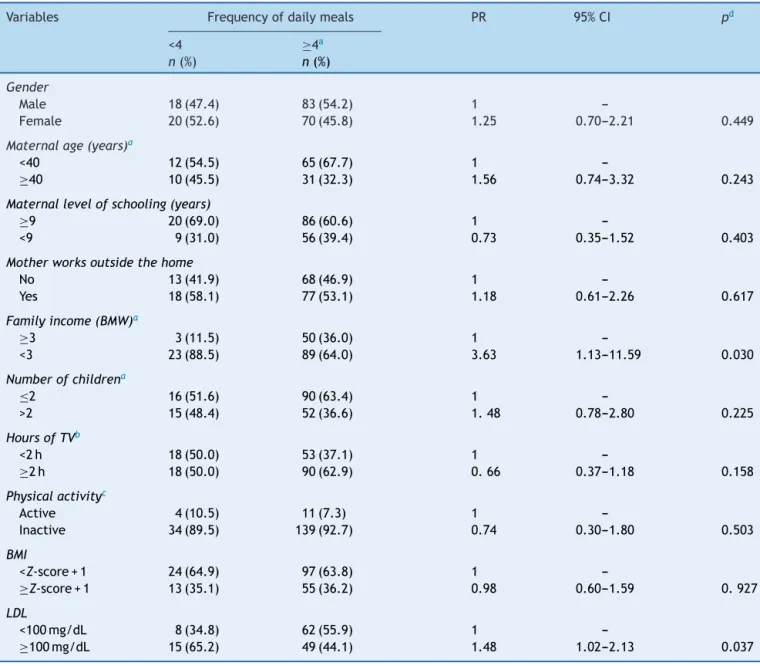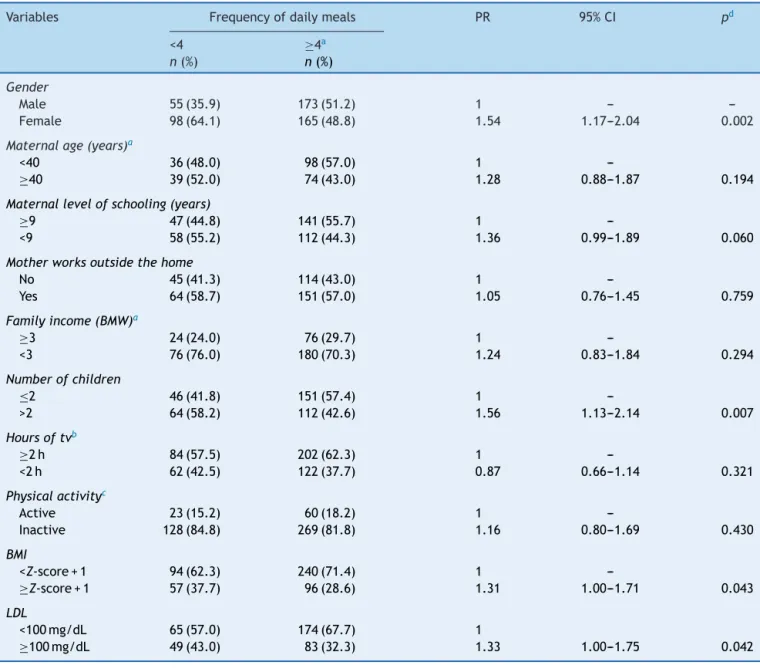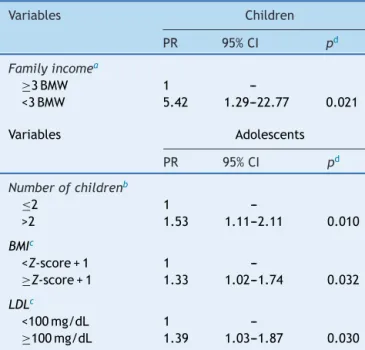www.jped.com.br
ORIGINAL
ARTICLE
Daily
meal
frequency
and
associated
variables
in
children
and
adolescents
夽
,
夽夽
Fabiana
A.
Silva
a,
Samara
M.
Candiá
a,
Marina
S.
Pequeno
a,
Daniela
S.
Sartorelli
b,
Larissa
L.
Mendes
c,
Renata
M.S.
Oliveira
a,
Michele
P.
Netto
a,
Ana
Paula
C.
Cândido
a,∗aUniversidadeFederaldeJuizdeFora(UFJF),DepartamentodeNutric¸ão,JuizdeFora,MG,Brazil
bUniversidadedeSãoPaulo(USP),FaculdadedeMedicinadeRibeirãoPreto,DepartamentodeMedicinaSocial, SãoPaulo,SP,Brazil
cUniversidadeFederaldeMinasGerais(UFMG),DepartamentodeNutric¸ão,BeloHorizonte,MG,Brazil
Received30October2015;accepted20April2016 Availableonline5July2016
KEYWORDS
Mealfrequency; Cardiovascularrisk factors;
Childrenand adolescents
Abstract
Objective: Toinvestigatethefrequencydistributionofdailymealsanditsrelationto
demo-graphic,socioeconomic,behavioral, anthropometricandbiochemicalfactorsinchildren and adolescents.
Methods: Thiswasacross-sectionalstudywitharepresentativesampleof708schoolchildren
aged 7---14years.Dataonpersonal information,socioeconomic status,physicalactivityand number ofmealswere obtained throughsemi-structuredquestionnaireandconsumption by 24-hrecallandfoodrecord.Weightandheightmeasurementswerealsoperformedtocalculate thebodymassindex.Finally,bloodsampleswerecollectedforanalysisoftotalcholesterol, high-andlowdensitylipoprotein,triglyceride, andglucoselevels.Descriptivestatistics,the Mann---Whitneytest,andPoissonregressionwereusedinstatisticalanalysis.
Results: Mealfrequency<4 wasassociatedinchildren,familyincome<3Brazilian minimum
wages(PR=5.42;95%CI:1.29---22.77;p=0.021)andadolescents,thenumberofsonsinthe fam-ily>2(PR=1.53;95%CI:1.11---2.11;p=0.010).Evenintheagegroupof10---14years,<4meals wasrelatedtohigherprevalenceofbodymassindex(PR=1.33;95%CI:1.02---1.74;p=0.032) andlow-densitylipoprotein(PR=1.39;95%CI:1.03---1.87;p=0.030)higherafteradjustments.
夽
Pleasecitethisarticleas:SilvaFA, CandiáSM,PequenoMS,SartorelliDS,MendesLL,OliveiraRM,etal.Dailymealfrequencyand associatedvariablesinchildrenandadolescents.JPediatr(RioJ).2017;93:79---86.
夽夽
Study conductedat the Departmentof Nutrition, Instituto de Ciências Biológicas, Universidade Federal de Juiz de Fora(UFJF), JuizdeFora,MG,Brazil
∗Correspondingauthor.
E-mail:anapaula.candido@ufjf.edu.br(A.P.Cândido). http://dx.doi.org/10.1016/j.jped.2016.04.008
Conclusion: Lowerfrequencyofmealswasrelatedtolowerincomeinchildrenandadolescents, largernumberofsonsinthefamily,andincreasedvaluesofbodymassindexandlow-density lipoprotein.
©2016SociedadeBrasileiradePediatria.PublishedbyElsevierEditoraLtda.Thisisanopen accessarticleundertheCCBY-NC-NDlicense(http://creativecommons.org/licenses/by-nc-nd/ 4.0/).
PALAVRAS-CHAVE
Frequênciade refeic¸ões; Fatoresderisco cardiovascular; Crianc¸ase adolescentes
Frequênciaderefeic¸õesdiáriasevariáveisassociadasemcrianc¸aseadolescentes
Resumo
Objetivo: Investigaradistribuic¸ãodafrequênciaderefeic¸õesdiáriasesuarelac¸ãocomfatores
demográficos,socioeconômicos,comportamentais,antropométricosebioquímicosemcrianc¸as eadolescentes.
Métodos: Estefoiumestudotransversalrealizadocomumaamostrarepresentativade
708esco-larescomidadesentre7e14anos.Osdadossobreinformac¸õespessoais,nívelsocioeconômico, atividadefísicaenúmeroderefeic¸õesforamobtidosatravésdequestionáriosemiestruturado eoconsumo atravésderecordatóriode 24heregistroalimentar.Medidasdepesoealtura também foramrealizadas para cálculo do índice de massa corporal. Por fim, coletaram-se amostras desangue para análisesde colesterol total, lipoproteína debaixa e de alta den-sidade, triglicerídeose glicemia. Análisesdescritivas, Mann-Whitneyeregressão dePoisson foramutilizadasnasanálisesestatísticas.
Resultados: Frequênciaderefeic¸ões<4seassociou,emcrianc¸as,arendafamiliar<3salários
(RP=5,42;IC95%:1,29-22,77;p=0,021)eemadolescentes,aonúmerodefilhosnafamília> 2(RP=1,53;IC95%:1,11-2,11;p=0,010).Aindanafaixaetáriade10a14anos,<4refeic¸ões serelacionouamaiorprevalênciadeíndicedemassacorporal(RP=1,33;IC95%:1,02-1,74; p=0,032)elipoproteínadebaixadensidade(RP=1,39;IC95%:1,03-1,87;p=0,030)elevados apósajustes.
Conclusão: Menorfrequênciaderefeic¸õesseassociouamenorrendaemcrianc¸aseem
adoles-centesamaiornúmerodefilhosnafamíliaevaloresaumentadosdeíndicedemassacorporal elipoproteínadebaixadensidade.
©2016SociedadeBrasileiradePediatria.PublicadoporElsevierEditoraLtda.Este ´eumartigo OpenAccesssobumalicenc¸aCCBY-NC-ND(http://creativecommons.org/licenses/by-nc-nd/4. 0/).
Introduction
Itiswellestablishedthatcardiovasculardiseases(CVD) orig-inateinchildhoodandthattwooftheirmainmodifiablerisk factors, overweight and dyslipidemia,have been increas-inglyobservedinchildrenandadolescents,whichareoften diagnosedwithatleastoneofthesefactors.1
The worldwide prevalence of childhood obesity has increasedconsiderablyoverthepastthreedecades,2---4 espe-cially in countries undergoing economic transitions that favor industrialization and urban and Western lifestyles,3 and,timeofexcessweightisdirectlyassociatedwith mor-talityfromCVD.5
Atherosclerosis is the physiopathological substrate for CVDthatbeginsinchildhoodanddevelopsovertheyears.1,6 Fatty streaks, the precursors of atherosclerotic plaques, appearinthe intimallayer ofthe aortaat threeyearsof ageandinthecoronariesduringadolescence,having dysli-pidemiaasatraditionalriskmarkerofthisprocess.7
Evidence to date attributes the increased prevalence of excess weight and dyslipidemias to the interaction between genetic and environmental factors. Regarding diet, the consumption of energy and macronutrients has beenwidelyinvestigated.However,theetiologyofexisting
eating models may not fully explain the development of therisk factorsfor CVD;eatingbehaviorsalsoneed tobe investigated.8
Among the variables related to these behaviors, a protective effect of higher frequency of daily meals on overweightandobesity hasbeen detectedin childrenand adolescents.9---11Furthermore,althoughthiseffecthasbeen observedmainlyinrelationtototalbodymass,ithasalso been observedinrelation todeleteriouschangesinserum lipids.11,12
Accordingtosomeauthors,thehabit ofskippingmeals contributes to dietary inadequacy and increased body weight,asthefoods commonlyconsumedincertainmeals arehardlyeatenatothertimesthroughoutthedayandmay evenbereplacedbyunhealthyfoods.13,14Inadditiontothis effect that may be mediated by changes in food intake, changes in the postprandial energy expenditure that can predisposetolong-termweightgain15 andincreasedserum cholesterol resulting from higher mean concentrations in plasma insulin peaksand greater areaunderthe curve of insulinresponseshavealsobeensuggestedinirregular eat-ingpatterns.
preventtheincreaseofbodyweightandhealthyserumlipid profilesinindividualsandpopulations,theaimofthisstudy wastoinvestigatethedistributionofthefrequencyofdaily meals and their association with demographic, socioeco-nomic,behavioral,anthropometric,andbiochemicalfactors inchildrenandadolescents.
Methods
Studypopulationandsamplingprocess
This epidemiologicalcross-sectional study wascarried out in 2012 witharepresentative sample of 708 children and adolescentsaged7---14-years-old,ofbothgenders,attending publicandprivateelementaryschoolsfromtheurbanarea ofthecityofJuizdeFora,stateofMinasGerais,Brazil.
Thedefinitionofsamplesize(n=708)wasbasedonthe followingcriteria:determinationofdesirablelevelsof accu-racyandsignificanceof2%and5%,respectively,establishing aprevalenceof8%obesityintheassessedagerange16 and 20%loss(noauthorizationfromparentsorstudentsto par-ticipatein the study). Twenty-sixstudents wereexcluded fornotadequatelyfillingoutquestionsrelatedtofrequency ofmeals.
The samplingprocess wascarried outin three phases, accordingtothefollowingorder:clustersampling,schools were randomly selected within each region of the city; proportionalstratifiedsampling,wherethenumberof indi-vidualssampledineachschoolgradewasproportionaltothe totalnumberofexistingstudentsineachoneofthem;and, simplerandomsampling,wheretheselectionofstudentsby schoolandgradewascarriedoutbydrawinglotsuntilthe numberofstudentsrequiredperschoolwasreached.
Datacollectiontools
The frequencyofmeals wasobtainedby applyinga struc-turedquestionnairecontainingthefollowingmealoptions: breakfast,morning snack,lunch, afternoonsnack, dinner, andeveningsnack, asking theparticipantstoidentify the mealsthat theyusuallyhad. Mealfrequencies were cate-gorizedaccordingtothemeanvalueofthisvariableinthe studypopulationasrisk(<4meals)andnorisk(≥4meals).
Thetoolsusedintheassessmentoffoodconsumption uti-lizeda24-hfoodrecallforeachresearchsubject,appliedby theresearcherwiththehelpofaphotoalbumanda three-day food record; the latter was given to the students or parents/guardianstobefilledoutathomeandreturnedon apreviouslyscheduleddate;theywereinstructedtoapply iteveryotherdayandtoincludeadayontheweekend. Sub-sequently,thedatawereenteredintheDietwin®(Dietwin®,
nutrition software, version 2008; Brazil) program for the analysisofdailyenergyconsumption.
The multiple source method program (Department of Epidemiology of theGerman Institute of Human Nutrition Potsdam-Rehbrücke, German) able to estimate the usual intake of each individual through adjustments from 24-h foodrecallsofthetotalsampleplusthreemorefoodrecords ofasubsample,wasusedtoestimatetheusualmeanintake inthetotalsample.
Watching two or more hours of TV daily was catego-rized as‘‘risk’’ based onrecommendations of the Expert Committee Recommendations Regarding the Prevention, Assessment,andTreatment ofChildand Adolescent Over-weightandObesity.17 Regardingthetotal timeof physical activity(TPA),children andadolescentswereclassified as activewhentheyperformed 300minor moreofmoderate orvigorousphysicalactivityweeklyandinactivewhenthey performed less than 300min, according to the classifica-tionusedintheNationalStudents’HealthSurvey(Pesquisa NacionaldeSaúdedoEscolar[PeNSE]2012).18
WeightwasmeasuredonaTanita®scale,IronmenBC-553
model(TanitaCorporationofAmerica ---ArlingtonHeights, USA) with a maximum capacity of 136kg and precision of 0.5kg. The individuals were weighed in the standing position, barefoot and wearing light clothes. Height was measuredusingan Alturexata® fieldstadiometer
(Alturex-ata,Brazil),bodymassindex(BMI)wascalculatedbasedon theobtainedvalues,andthechildrenandadolescentswere classifiedas havingexcess weight(overweight or obesity) basedonBMIforage≥Zscore+1,accordingtothelimits proposedbytheWHO.19
Bloodsampleswereobtainedfromtheindividualsafter a12-hfast.Biochemicalmeasurementsoftotalcholesterol andfractions(HDLandLDL),triglycerides,andglucosewere performed. Alterations in serum lipids and glucose were analyzed according to the V Brazilian Guideline on DyslipidemiaandAtherosclerosisPrevention20andaccording tothecriteriaoftheNational DiabetesEducation Program (NDEP),respectively,considering theborderlinevaluesfor serumlipidsandfastingbloodglucoselevels≥100mg/dLas riskfactors.
Statisticalanalysis
Thenormalityofthedatawasverifiedbythe Kolmogorov---Smirnovtest.Subsequently,descriptiveanalysisstratifiedby agerangewasperformed andtheMann---Whitneytest was usedtoidentifysignificantdifferencesbetweenthevalues ofthecentraltendencymeasures.
Toanalyzetheassociationsbetweenfrequencyofmeals andthevariablesofinterest,crudePoissonregressionand Poissonregressionadjustedwithrobustvarianceadjustment andcontrolforthedesigneffectwereused.Variableswitha significancelevel≤0.20orthosethatcouldrepresent poten-tialconfoundingfactorswereincludedinthemodels.
Differencesbetweenvalueswereconsideredstatistically significantforp<0.05.Statisticalanalyseswereperformed usingSPSS(SPSS®,version13.0,USA)andStata(Stata,
ver-sion10.1,USA).
Ethicalaspects
Table1 Demographic,anthropometric,biochemical,behavioral,anddietarycharacteristicsofchildrenandadolescents.
Variables n Childrena n Adolescentsa pb
Age(years) 205 8.00(5---9) 500 12.00(10---16) <0.001
BMI(kg/m2) 204 16.66(12.4---32.5) 499 18.75(13---40.3) <0.001
TC(mg/dL) 185 158.00(99---243) 468 152.00(82---249) 0.021
HDL(mg/dL) 141 49.00(27---90) 378 47.00(22---89) 0.097
LDL(mg/dL) 141 97.00(11---178) 378 91.00(29---162) 0.021
TG(mg/dL) 184 59.50(19---231) 468 63.00(11---272) 0.536
GLU(mg/dL) 180 79.00(23---118) 463 82.00(23---104) <0.001
TPA(min) 197 79.61(±101.51) 491 113.42(±142.47) 0.030
Dailymeals 191 4.31(±1.03) 491 3.99(±1.03) <0.001
Calories/day 190 1701.79(697.76---2996.21) 490 1700.82(622.82---3763.02) 0.830
BMI,bodymassindex;TC,totalcholesterol;HDL,high-densitylipoprotein;LDL,low-densitylipoprotein;TG,triglycerides;GLU,glucose; TPA,totaltimeofphysicalactivity.
aDataexpressedasmedianandminimumandmaximumrangesormean±standarddeviation. b Wilcoxon---Mann---Whitneytest.
Results
Ofthe708studentsaged7---14years,682correctlyanswered questionsrelatedtothenumber ofmeals and,therefore, comprisethesubsampleofthisarticle.Ofthese,1.68%were fromprivateschoolsand98.32%frompublicschools;47.66% wereboysand52.34%girls,withameanageof10.82±2.14 years,withnodifferenceinmeanagebygender(p=0.981). Inthesample,35.5%ofthechildrenand31.5%ofthe ado-lescentshadexcessweight.
BMI, fasting glucose levels, and TPA were significantly higher among adolescents;however, the children showed highervalues of TC, LDL,and a higher numberof meals, andenergyconsumptiondidnotvarysignificantlyaccording toagerange(Table1).
Thehabitofhavingfourormoremealswassignificantly moreprevalentamongchildren(80.1%)thanamong adoles-cents(68.8%; p=0.003) and more prevalentamongmales (77.9%)whencomparedtofemales(66.6%;p=0.001;data notshown).
Among the adolescents, girls that had fewer than fourmeals had a 1.53-fold (PR=1.53; 95% CI: 1.06---2.22; p=0.022) higher risk of having excess weight when com-paredtothosewithamorefrequent patternofmeals.No significantdifferenceswereobservedregardingthe preva-lenceratioofexcessweightforthedifferentmealpatterns inmaleadolescentsandchildrenofbothgenders(datanot shown).
TPAand themedian caloricintakedid notvary signifi-cantlybetweenchildrenwhohadfewerthanfourmealsvs. fourormoremeals.Adolescentsalsoshowednodifferences inTPAaccordingtothefrequencyofmeals.However,among adolescents,themediancaloricintakewashigher(p<0.001) among individuals who consumed four or more meals thanamongindividualswhoconsumedfewerthanfour(data notshown).
Amongtheindividualswhohadfewerthanfourmealsa day,supperwasthemostoftenskippedmealbythechildren (66.0%)andadolescents(77.3%),followedbysnacks,which wereskippedby60.0%ofchildrenand61.0%ofadolescents, andbreakfast, skippedby 32.0% of children and34.8% of adolescents(datanotshown).
No significant differences were observed in children regarding the different skipped meals by gender; how-ever,amongadolescents,girlsmoreoftenskippedbreakfast (34.9% vs. 23.3; p=0.009) and lunch (11.2% vs. 5.6; p=0.050) when compared to boys, whereas snacks were moreoftenskippedbymalesthanfemales(60.3%vs.49.1, p=0.034;datanotshown).
Table2shows theunadjusted Poissonregression analy-sis in children, demonstrating that the prevalence of the pattern of less than four meals/day was higher among individuals with lower family income (PR=3.63; 95% CI: 1.13---11.59;p=0.030)andthatthispatternwasassociated withahigherprevalenceofincreasedLDL(PR=1.48;95%CI: 1.02---2.13;p=0.037).
In adolescents(Table 3), the pattern of less than four meals perday wasmoreprevalentamonggirls (PR=1.54; 95%CI:1.17---2.04;p=0.002)andamongfamilieswithmore thantwochildren(PR=1.56;95%CI:1.132.14;p=0.007). In turn,thispattern ofmealswasalsodirectly associated withincreasedBMI(PR=1.31;95%CI:1.00---1.71;p=0.043) andLDLlevels(PR=1.33;95%CI:1.00---1.75;p=0.042).The other biochemical variables were not related to the fre-quencyofmeals.
Table4illustratestheadjustedPoissonregression anal-ysis.Inthemodel,alowerfrequencyofmealsshowed,as anassociatedfactorinchildren,familyincomebelowthree Brazilian minimum wages (PR=5.42; 95% CI: 1.29---22.77; p=0.021) and in adolescents, more than two children (PR=1.53; 95% CI: 1.11---2.11; p=0.010). Also in the age rangeof10---14years,individualswithfewermealsshowed a higher chance of having elevated BMI (PR=1.33; 95% CI:1.02---1.74;p=0.032)andLDLlevels(PR=1.39;95%CI: 1.03---1.87;p=0.030),aftertheadjustments.
Discussion
Table2 Frequencydistributionofdailymealsandcrudeprevalenceratioaccordingtodemographic,socioeconomic,dietary, behavioral,anthropometric,andbiochemicalvariablesofchildren,JuizdeFora,MG,Brazil,2012.
Variables Frequencyofdailymeals PR 95%CI pd
<4
n(%)
≥4a n(%)
Gender
Male 18(47.4) 83(54.2) 1
---Female 20(52.6) 70(45.8) 1.25 0.70---2.21 0.449
Maternalage(years)a
<40 12(54.5) 65(67.7) 1
---≥40 10(45.5) 31(32.3) 1.56 0.74---3.32 0.243
Maternallevelofschooling(years)
≥9 20(69.0) 86(60.6) 1
---<9 9(31.0) 56(39.4) 0.73 0.35---1.52 0.403
Motherworksoutsidethehome
No 13(41.9) 68(46.9) 1
---Yes 18(58.1) 77(53.1) 1.18 0.61---2.26 0.617
Familyincome(BMW)a
≥3 3(11.5) 50(36.0) 1
---<3 23(88.5) 89(64.0) 3.63 1.13---11.59 0.030
Numberofchildrena
≤2 16(51.6) 90(63.4) 1
--->2 15(48.4) 52(36.6) 1.48 0.78---2.80 0.225
HoursofTVb
<2h 18(50.0) 53(37.1) 1
---≥2h 18(50.0) 90(62.9) 0.66 0.37---1.18 0.158
Physicalactivityc
Active 4(10.5) 11(7.3) 1
---Inactive 34(89.5) 139(92.7) 0.74 0.30---1.80 0.503
BMI
<Z-score+1 24(64.9) 97(63.8) 1
---≥Z-score+1 13(35.1) 55(36.2) 0.98 0.60---1.59 0.927
LDL
<100mg/dL 8(34.8) 62(55.9) 1
---≥100mg/dL 15(65.2) 49(44.1) 1.48 1.02---2.13 0.037
BMI,bodymassindex;LDL,low-densitylipoprotein;BMW,Brazilianminimumwages.
a Cutoffaccordingtothemedianofthestudiedpopulation. b NumberofdailyhoursofTVduringtheweek.
c Active:≥300minofphysicalactivity/week;inactive:<300minofphysicalactivity/week. d Poissonregression.
the country by the Household Budget Survey (Pesquisa de Orc¸amentos Familiares [POF] 2008/2009) in children (49.8%)andweresimilartoadolescents(30.0%)atthesame ageranges.16
Asexpected,theassociationbetweenfrequencyofmeals andgenderwasobservedinthepresentstudyaswellasin others,withthehabitofskippingmealsbeingmorefrequent in thefemale gender.Among the reasonsfor thisfinding, theauthorshighlightconcernwithbodyimage,particularly amonggirls,commonlyleadingtothepracticeofrestrictive dietswithoutexpertguidance,inwhichskippingmealsisa commonpractice.21
Other studies indicate that skipping meals is also a morecommonphenomenonamongadolescentsthanamong
children, which is justified by the common eating irregularityatthatphaseofdevelopment,eitherby adher-ingtorestrictivedietswithoutfollow-up,orduetochanges in their life styles, such as greater autonomy to make foodchoices,need for convenience,mediainfluence,and preference for certainflavors.22,23 Skippingmeals such as breakfast18 often occurs in this population group, or the replacementofmainmealsforsnacksorquickmeals.24
Table3 Frequencydistributionofdailymealsandprevalenceratioaccordingtodemographic,socioeconomic,dietary, behav-ioral,anthropometric,andbiochemicalvariablesofadolescents,JuizdeFora,MG,Brazil,2012.
Variables Frequencyofdailymeals PR 95%CI pd
<4
n(%)
≥4a n(%)
Gender
Male 55(35.9) 173(51.2) 1 ---
---Female 98(64.1) 165(48.8) 1.54 1.17---2.04 0.002
Maternalage(years)a
<40 36(48.0) 98(57.0) 1
---≥40 39(52.0) 74(43.0) 1.28 0.88---1.87 0.194
Maternallevelofschooling(years)
≥9 47(44.8) 141(55.7) 1
---<9 58(55.2) 112(44.3) 1.36 0.99---1.89 0.060
Motherworksoutsidethehome
No 45(41.3) 114(43.0) 1
---Yes 64(58.7) 151(57.0) 1.05 0.76---1.45 0.759
Familyincome(BMW)a
≥3 24(24.0) 76(29.7) 1
---<3 76(76.0) 180(70.3) 1.24 0.83---1.84 0.294
Numberofchildren
≤2 46(41.8) 151(57.4) 1
--->2 64(58.2) 112(42.6) 1.56 1.13---2.14 0.007
Hoursoftvb
≥2h 84(57.5) 202(62.3) 1
---<2h 62(42.5) 122(37.7) 0.87 0.66---1.14 0.321
Physicalactivityc
Active 23(15.2) 60(18.2) 1
---Inactive 128(84.8) 269(81.8) 1.16 0.80---1.69 0.430
BMI
<Z-score+1 94(62.3) 240(71.4) 1
---≥Z-score+1 57(37.7) 96(28.6) 1.31 1.00---1.71 0.043
LDL
<100mg/dL 65(57.0) 174(67.7) 1
≥100mg/dL 49(43.0) 83(32.3) 1.33 1.00---1.75 0.042
BMI,bodymassindex;LDL,low-densitylipoprotein;BMW,Brazilianminimumwages.
aCutoffaccordingtothemedianofthestudiedpopulation. b NumberofdailyhoursofTVduringtheweek.
c Active:≥300minofphysicalactivity/week;inactive:<300minofphysicalactivity/week. d Poissonregression.
cross-sectionalstudies,inwhichreversecausalitycanmask theeffectsofsomeinvestigatedassociations.25
Theresultssuggestthateffortstoincreasethenumberof mealsamongchildrenshouldprioritizefamilieswithlower income,asit iswell establishedthatfoodhabitsare sub-jecttothepurchasingpowerofhouseholds,whichdepend ontheavailability,quantity,andqualityofconsumedfood. Inthissense,schoolshavethepotentialtoprovidehealthy andaccessiblemealoptionstostudentsfromfamilieswith lowerincomes.
Amongadolescents,itwasfoundthatthetotalnumber of children per household should be considered in deter-mining mealstandards.The presence ofmore children in the family increases the demand for food, compromising
availability. According to Hoffmann, the food insecurity situationispositivelyaffectedbythepresenceofahigher number of individuals under 18 years and the number of individuals perhousehold.26 Additionally, a highernumber ofchildren mayalsointerfereinthemother’shealth care totheseadolescents.
Table 4 Association between frequency of daily meals lowerthanfour andsocioeconomic,demographic, anthro-pometric, and biochemical variables, in children and adolescents,JuizdeFora,MG,Brazil,2012.
Variables Children
PR 95%CI pd
Familyincomea
≥3BMW 1
---<3BMW 5.42 1.29---22.77 0.021
Variables Adolescents
PR 95%CI pd
Numberofchildrenb
≤2 1
--->2 1.53 1.11---2.11 0.010
BMIc
<Z-score+1 1
---≥Z-score+1 1.33 1.02---1.74 0.032
LDLc
<100mg/dL 1
---≥100mg/dL 1.39 1.03---1.87 0.030
LDL,low-densitylipoprotein;BMW,Brazilianminimumwages.
a IncludesgenderandhoursofTV. b Includesgender.
c Includes gender, energy intake, and physical activity
classification.
d ValuesrelatedtotheadjustedPoissonregression.
withoverallincreasedthermiceffectoffoodwithregular mealpatterns.15
In this study,lowerLDL serumlevelswere also associ-ated with a higher frequency of meals in adolescents. It is believed that possible mechanismsare thelower mean concentrationsinplasmainsulinpeaksandthesmallerarea under the curve for insulin responses with regular eating patterns,27causingreductionofhepaticsynthesisand activ-ityof theenzyme 3-hydroxy-3-methylglutarylcoenzyme A reductase to occur. This enzyme acts by decreasing the secretion of lipoproteins containing apolipoprotein B and increasing the synthesis of hepatic LDL receptors, conse-quentlydecreasingtheirserumlevels.28
Somestudieshaveindicatedthatalthoughasmaller num-berofmealsisrelatedtoalowerdailyenergyintake,there maybean increase incaloricintakeper meal,which is a strong indicator of deleterious metabolic profiles such as glucose intolerance and dyslipidemia.29 This may explain whythe association betweena higherfrequency of meals andserumLDL levelscan beobserved eveninindividuals withnormalweight.
In addition to the cross-sectional design, which pre-vents conclusions on causal associations, this study has aslimitations the difficultytostandardize whatwould be definedasamealandconcomitantunder-reportingoffood intakeand foodfrequency. This under-reporting hasbeen widelyacknowledged,anditisparticularlyevidentin indi-vidualswithexcessweightregardingthereportingofsnacks comparedwiththemainmeals.30
In conclusion, this analysis indicated that the habit of havingfourormoremealsa dayisassociatedwith demo-graphic, socioeconomic,anthropometric, and biochemical factors.Itwasfoundthathighermealsfrequenciesaremore oftenobservedinchildrenwhencomparedwithadolescents, as well as in males compared to females; higher family incomevaluesandfewerchildreninthefamilyalsofavoran increaseinthefrequencyofmealsinchildrenand adoles-cents,respectively.Moreover,ahighernumberofmealscan contributetoweightcontrolandbetterserumLDLprofilein adolescents.
Funding
Conselho Nacional de Desenvolvimento Científico e Tec-nológico(CNPq),Fundac¸ãodeAmparoàPesquisadoEstado deMinasGerais(FAPEMIG),andUniversidadeFederaldeJuiz deFora(UFJF).
Conflicts
of
interest
Theauthorsdeclarenoconflictsofinterest.
Acknowledgements
ToConselhoNacionaldeDesenvolvimentoCientíficoe Tec-nológico(CNPq--- 476016/2010-0), Fundac¸ão deAmparo à PesquisadoEstadodeMinasGerais(FAPEMIG),and Univer-sidadeFederaldeJuizdeFora.
References
1.World Health Organization (WHO). World health statistics. Geneva:WorldHealthOrganization;2014.
2.JoanCH,DebbieAL,SueYS.Childhoodobesity---2010:progress andchallenges.Lancet.2010;375:1737---48.
3.OrsiCM,HaleDE,LynchJL.Pediatricobesityepidemiology.Curr OpinEndocrinolDiabetesObes.2011;18:14---22.
4.LobsteinT, Jackson-LeachR,MoodieML,HallKD,Gortmaker SL,SwinburnBA,etal.Childandadolescentobesity:partofa biggerpicture.Lancet.2015;385:2510---20.
5.Freedman DS, Dietz WH, Srinivasan SR, Berenson GS. The relationofoverweighttocardiovascularriskfactorsamong chil-dren and adolescents: the Bogalusa Heart Study. Pediatrics. 1999;103:1175---82.
6.Johnson W, Kuh D, Tikhonoff V, Charakida M, Woodside J, WhincupP,etal.Bodymassindexandheightfrominfancyto adulthoodandcarotidintima-mediathicknessat60to64years inthe1946BritishBirthCohortStudy.ArteriosclerThrombVasc Biol.2014;34:654---60.
7.FordES.C-reactive proteinconcentrationand cardiovascular disease risk factors in children: findings from the National Healthand NutritionExaminationSurvey1999---2000. Circula-tion.2003;108:1053---8.
8.KaisariP,YannakouliaM,PanagiotakosDB.Eatingfrequencyand overweightandobesity inchildrenand adolescents:a meta-analysis.Pediatrics.2013;131:958---67.
10.KoletzkoB,ToschkeAM.Mealpatternsandfrequencies:dothey affectbodyweightinchildrenandadolescents?CritRevFood SciNutr.2010;50:100---5.
11.JäskeläinenA, SchwabU,KolehmainenM,Pirkola J,Järvelin MRJ. Associations of meal frequency and breakfast with obesityandmetabolicsyndrometraitsinadolescentsof North-ern Finland Birth Cohort 1986. Nutr Metab Cardiovasc Dis. 2013;23:1002---9.
12.Murakami K, Livingstone MB. Associations of eating fre-quency with adiposity measures, blood lipid profiles and bloodpressureinBritishchildrenandadolescents.BrJNutr. 2014;111:2176---83.
13.Estima CC, Costa RS, Sichieri R, Pereira RA, Veiga GV. Mealconsumptionpatternsandanthropometricmeasurements in adolescents from a low socioeconomic neighborhood in the metropolitan area of Rio de Janeiro, Brazil. Appetite. 2009;52:735---9.
14.LealGV,PhilippiST,MatsudoSM,ToassaEC.Consumoalimentar epadrãoderefeic¸õesdeadolescentes,SãoPaulo,Brasil.Rev BrasEpidemiol.2010;13:457---67.
15.Ohkawara K, Cornier MA, Kohrt WM, Melanson EL. Effects of increasedmeal frequency onfat oxidationand perceived hunger.Obesity(SilverSpring).2013;21:336---43.
16.Brasil. Ministério do Planejamento, Orc¸amento e Gestão, Instituto Brasileiro de Geografia e Estatística, Pesquisa de orc¸amentos familiares 2008---2009. Antropometria e Estado NutricionaldeCrianc¸as,adolescenteseadultosnoBrasil.Rio deJaneiro:IBGE;2010.
17.Barlow SE, Expert C. Expert committee recommendations regardingtheprevention,assessment,andtreatmentofchild andadolescentoverweightandobesity:summaryreport. Pedi-atrics.2007;120:164---92.
18.Brasil.InstitutoBrasileirodeGeografiaeEstatística.Pesquisa NacionaldeSaúdedoEscolar(PeNSE)---2012.RiodeJaneiro: IBGE; 2013. Available from: http://biblioteca.ibge.gov.br/ visualizacao/livros/liv64436.pdf[cited30.10.15].
19.OnisM,OnyangoAW,BorghiE,SiyamA,NishidaC,SiekmannJ. DevelopmentofaWHOgrowthreferenceforschool-aged chil-drenandadolescents.BullWorldHealthOrgan.2007;85:660---7.
20.SociedadeBrasileiradeCardiologia/SBC.VDiretrizbrasileirade dislipidemiaseprevenc¸ãodaaterosclerose.ArqBrasCardiol. 2013;101:36.
21.Rampersaud GC.Benefits ofbreakfast for children and ado-lescents:updateand recommendations forpractitioners. Am JLifestyleMed.2009;3:86---103.
22.TeixeiraAS,PhilippiST,LealGV,ArakiEL,EstimaCC,Guerreiro RE.Substituic¸ãoderefeic¸õesporlanchesemadolescentes.Rev PaulPediatr.2012;30:330---7.
23.CurrieC,ZanottiC,MorganA, CurrieD,LoozeM,RobertsC, etal.Socialdeterminantsofhealthandwell-beingamongyoung people.HealthBehaviourinSchool-agedChildren(HBSC)study: internationalreportfromthe2009/2010survey.Copenhagen: WHORegionalOfficeforEurope;2012(HealthPolicyfor Chil-drenandAdolescents,No.6).
24.El-GilanyAH,ElkhawagaG.Socioeconomicdeterminantsof eat-ingpatternofadolescentstudentsinMansoura.EgyptPanAfr MedJ.2012;13:22.
25.JenningsA,CassidyA,vanSluijsEMF,GriffinSJ,WelchAA. Asso-ciationsbetweeneatingfrequency,adiposity,diet,andactivity inhealthyweightandcentrallyobesechildren9---10years. Obe-sity(SilverSpring).2012;20:1462---8.
26.HoffmannR.Determinantesdainseguranc¸aalimentarnoBrasil: snálise dos dados da PNAD de 2004. Segur Aliment Nutr. 2008;15:49---61.
27.SalehiM,KazemiA,HasanZadehJ.Theeffectsof6isocaloric mealspatternonbloodlipidprofile,glucose,hemoglobina1c, insulinandmalondialdehydeintype2diabeticpatients:a ran-domizedclinicaltrial.IranJMedSci.2014;39:433---9.
28.ArnoldLM,BallMJ,DuncanAW,MannJ.Effectofisoenergetic intakeofthreeorninemealsonplasmalipoproteinsandglucose metabolism.AmJClinNutr.1993;57:446---51.
29.HouseBT, CookLT, GyllenhammerLE, SchrawJM,Goran MI, Spruijt-MetzD,etal.Mealskippinglinkedtoincreasedvisceral adiposetissueandtriglyceridesinoverweightminorityyouth. Obesity(SilverSpring).2014;22:77---84.



